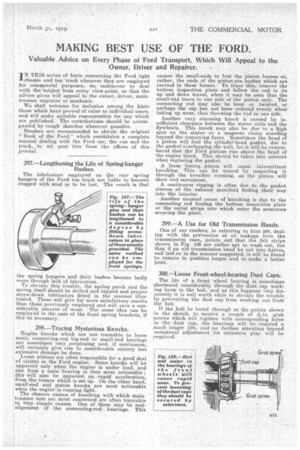MAKING BEST USE OF THE FORD.
Page 15

If you've noticed an error in this article please click here to report it so we can fix it.
Valuable Advice on Every Phase of Ford Transport, Which Will Appeal to the Owner, Driver and Repairer.
N THIS series of hints concerning the Ford light
chassis and -ton truck wherever they are employed for commercial purposes, we endeavour to deal with the subject from every view-point, so that the advice given will appeal to the owner, driver, maintenance engineer or mechanic.
We shall welcome for inclusion among the hints those which have proved of value to individual users, and will make suitable remuneration for any which are published. The contributions should be accompanied by rough sketches wherever possible. Readers are recommended to obtain the original "Book of the Ford," which constitutes a complete manual dealing with the Ford car, the van and the truck, as. ad. post free from the offices of this journal.
297.—Lengthening the Life of Spring-hanger Bushes.
The lubricators employed on the rear spring hangers of the Ford ton truck are liable to become clogged with mud or to be lost. The result is that the spring hangers and their bushes become badly worn through lack of lubrication. •• To obviate this trouble, the spring perch and the spring itself should be drilled and tapped and proper screw-down lubricators fitted in the manner illustrated. These will give far more satisfactory results than those previously employed and will save a considerable amount of wear. The same idea can be employed in the case of the front spring brackets, if this be necessary.
298.—Tracing Mysterious Knocks.
Engine knocks which are not traceable to loose main, connecting-rod big-end or small-end bearings are sometimes very perplexing and, if continuous, will certainly give rise to considerable anxiety lest extensive damage be done. Loose pistons are often responsible for a good deal of clatter in the Ford engine. Some knocks will be apparent only when the engine is under load, and one from a main bearing is then most noticeable ; this will also be apparent on rapid acceleration, from the tremor which is set up. On the other hand, small-end and piston knocks are most noticeable when the engine is running light. The obscure causes of knocking with which maintenance men arc most concerned are often traceable to very simple causes. One of these may be malalignment of the connecting-rod bearings. This causes the small-ends to foul the piston bosses or, rather, the ends of the piston-pin bushes which are carried in these bosses. To trace this, remove the bottom inspection plate and follow the rod in its up and down travel, when it may be seen that the small-end bears to one side of the piston only. The connecting rod may also be bent or twisted, or perhaps the cap has not been reduced evenly when' taking up wear, thus throwing the rod to one side.
Another very alarming knock is caused by insufficient clearance between the stator coils and the flywheels. This knock may also be due to a high spot on the stator or a magneto clamp standing beyond the remaining faces. Sometimes the head of a piston will foul the cylinder-head gasket, (hie to the gasket overlapping the wall, for it will be remembered that the Ford pistons rise above the head of the engine block. This should be taken into account when replacing the gasket.
A loose timing pinion will cause intermittent knocking. This can be traced by inspecting it through the breather opening, as the pinion will show end movement.
A continuous ringing is often due to the gasket sleeves of the exhaust manifold finding their way into the interior.
Another unusual cause of knocking is due to the connecting rod fouling the bottom inspection plate or the metal strips into which enter the setscrews securing the plate.
299.—A Use for Old Transmission Bands.
One of our readers, in referring to hint 260, dealing with the prevention of oil leakage from the transmission case, points out that the felt strips shown in Fig. 139 are rather apt to wash out, but that if an old transmission band be cut into halves, and laid on in the manner suggested, it will be found to remain in position longer and to make a better joint.
300.—Loose Front-wheel-bearing Dust Caps.
The life of a front wheel bearing is sometimes shortened considerably through the dust cap working loose in the hub, and as this happens very frequently it is well worth while to obviate the trouble by preventing the dust cap from working out from the hub.
If the hub be bored through at the points shown
in the sketch, to receive a couple of grub• screws which will register with corresponding holes in the dust cap, the bearings will be ensured a much longer life, and no further attention beyond occasional adjustment for excessive play will be required.




























